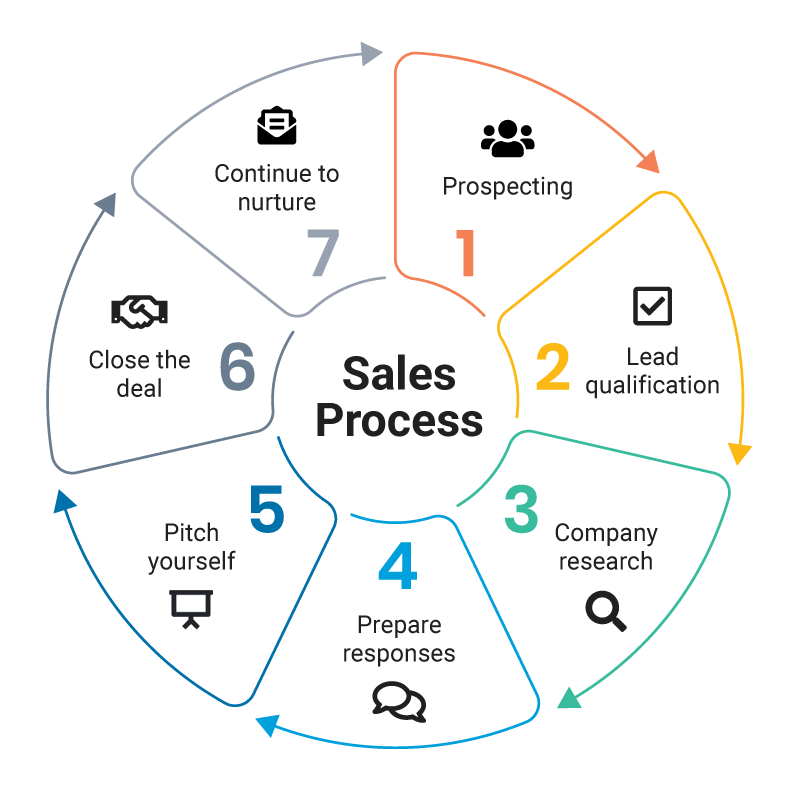When it comes to making a sale, you’ve undoubtedly performed a bit of improv. After all, every good sales person knows the importance of finding ways to make the customer feel at ease—and every customer is different!
However, it’s also important for your sales efforts to have a reliable structure when selling to other businesses. In using one, you can not only increase your sales rates, but you may also find that you’re attracting and converting more customers.
This reliable structure is what is known as a sales process.
But a sales process isn’t only meaningful to you as an individual. It can also benefit an entire sales team. By doing so, companies help ensure their customers receive a unified experience, no matter who they may connect with.
Below we break down the steps you’ll need to take to go from what is a sales process to creating the perfect sales process for your business.
MQLs or SQLs
In its most basic form, a “sales process” refers to the repeatable steps taken by a sales individual or team taking someone from being a sales lead to being a closed customer.
Knowing what your ideal customer looks like is critical to your sales process. That is because not every single lead your business collects will turn into a sale. And that’s perfectly normal! In marketing your business, you’ll undoubtedly collect information from people that could relate to your message—but perhaps don’t require your product or service.
So, what is a sales lead? There are two types of leads you may attract with your sales process: Marketing Qualified Lead or an MQL and SQL or a Sales Qualified Lead.
An MQL is ultimately an unqualified sales lead that you collect through mass marketing efforts like:
- Requiring a sign up for a workshop you host
- Requesting an email address in exchange for your newsletter or a free gift
- Requiring someone to sign up in order to receive your newsletter
Meanwhile a Sales Qualified Lead is a lead that your sales efforts should be focused around. That’s because these people match your ICA or Ideal Customer Avatar—they are your ideal customers!
Being able to target an SQL over an MQL takes a bit of work, but it should all be a part of what becomes your sales process.
The seven steps of sales
The best sales processes consist of seven total steps. It’s important that each step be taken in order. This will not only help you avoid spending valuable time and resources on MQLs but it’s more likely to lead to consistent, long-term success.


Prospecting
This is what businesses do in order to find new leads—prospecting means you are identifying possible customers for your business. In this step you gather any and all potential leads that come your way.
Maybe you do this through purchasing a list of business leads or a list of consumer leads. You can also collect personal information like name, phone number, and address, from people who visit your store or website or even your event booth.

Lead qualification
Now that you have a list of prospects, you or your sales team needs to decide which leads are MQLs and which ones are SQLs. This is called lead qualification.
Not everyone will be a good fit for your product or service. And it’s when businesses try to sell to everyone that they end up selling to no one! That is why this step in the sales process is so critical.
Qualifying leads is often done through a “discovery call” wherein a sales rep will connect with an MQL by phone and ask qualifying questions that relate back to what they’re trying to sell. For instance, if your company is trying to sell printer ink to large companies, your qualifying questions might look like this:
- What is your current role at X company?
- What type of printer are you using?
- Do you plan on replacing your printer in the near future?
- Do you have a budget allocated for office supplies?
- What is the sign off process for your office supply budget?
- How much are you currently spending on printer ink?
If your ideal customer has twelve floors of office space and uses twenty printers all day every day, but you’re speaking to a small non-profit using a single printer twice per day, they would not be an SQL.
If on your discovery call you realize someone is not an ideal customer, you don’t need to delete them from your list—they may still qualify one day! However, you no longer need to actively pursue them as a potential sale.

Company research
Once you determine that someone is an SQL, your work isn’t done. It’s then that you want to perform additional research into their company. By coming to better understand the company your SQL works for, you are able to practice empathy with your SQL and put yourself in their position. What can you do to make your offer tailored to the needs of not only his/her company process, but also personalize the experience?
By coming to better understand the challenges your SQL is facing and promoting your product or service as a solution to that challenge, you stand a higher likelihood of closing out your deal.
It’s okay to connect with other leads that work within the same company as part of your research. It will not only help you understand the bigger picture of how an organization works, but may give you more insights into their objectives.

Prepare responses to common objections
Almost every SQL will have an objection to what you’re trying to sell them. This is a totally normal part of the sales process. It is on you, as the seller, to be as prepared as possible to handle those objections.
Your company should already be somewhat familiar with objections that have arisen around your product or service. From its cost to ease of learning it, to level of customer service, you should identify every possible common objective your SQL could have following your pitch in the next step—and be prepared with a response. If you don’t know the answer, ask around until you find out. This may mean collaborating with different departments including IT or marketing.

Pitch yourself
Once you’ve collected all of the information about your SQL and their company, it’s time to present your case and try to sell something! Sometimes this comes in the form of a demonstration of your product or service while other times, it’s simply a sales call.
Every single pitch you make should be specifically tailored to the individual that you have researched and come to know. By listing specific pain points they are experiencing and plugging in the solutions your product or service can provide, you make yourself look more enticing than if you provide a one-size-fits-all pitch.
This step may also include sending over things like a proposal or a quote.

Close the deal
This is the pinnacle of every sales effort—actually making the sale! A contractual agreement, closing the deal should benefit both the prospect and the seller. Once the deal officially closes, many sales reps will receive their commission, usually based on the total sale that was negotiated.

Continue to nurture
Many sales reps make the mistake of thinking a sale is the end of the sales process. However, products and services can often be purchased multiple times. And if you sell to your customer then leave them high and dry for months until you need a new sale—they may not be as willing to buy from you when you come back around.
Continue to communicate with your purchaser and ensure they’re pleased with what they received. Build a relationship. That is the surest way to re-sell, upsell, or even cross-sell in the future.
There you have it! More information regarding what is a sales process and hopefully giving you ideas for how to create one that fits your company’s needs.







